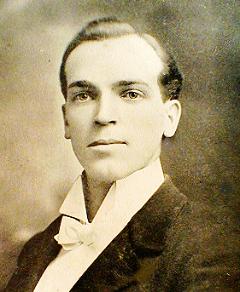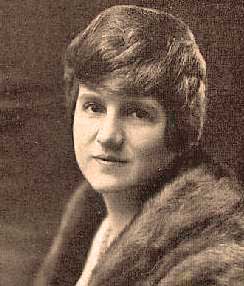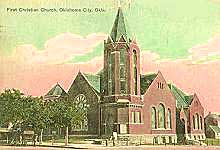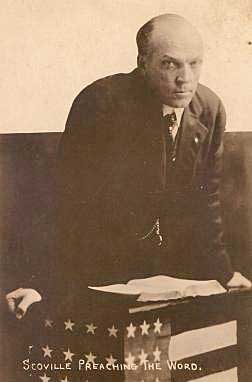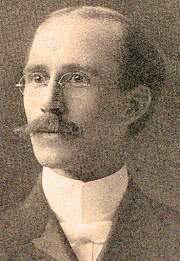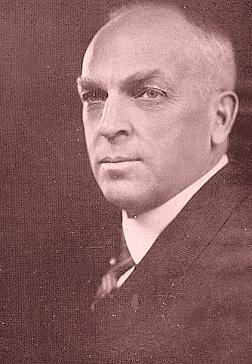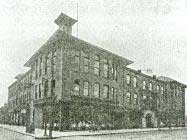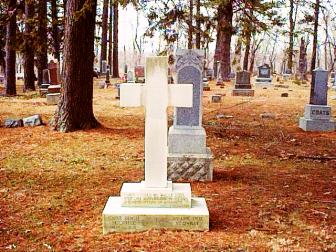Main Pioneer Menu | Profiles Index | Search Engine | PL
Charles Reign Scoville
Turn-of-the-Century Evangelist
in Oregon and Washington
By Charles Dailey - Updated July 5, 2013
| Charles R. Scoville at a Glance: | |
| Born: | 1869 in West Milford, Ohio |
| Education: | Hiram College, A.B. & A. M. 1898
Drake University, LL. D. in 1901 |
| Married: | Arlene Dux in 1906 |
| Sample Sermon: | The Resurrection (1901) |
| Evangelistic Campaigns in the Northwest: | Albany, OR - 1900
Portland, OR Yakima, WA - 1909 Spokane, WA - 1910 Pendleton, OR - 1910 (building dedication) Eugene, OR - 1911 Tacoma, WA - 1910 Puyallup, WA |
| Died: | 1938 - Garden City, Kansas |
| Buried: | Newville, Indiana |
Scoville at 23 Arlene Dux Scoville's Evangelistic team A Try at Union Meetings Australia and Chicago R. A. Long - Backer? Inspiration Point "Christ is King." Final Matters Charles Reign Scoville was the most effective mass-evangelist among the Churches of Christ and Christian Churches since the Church was established on Pentecost. C. D. Hall, Dean of Texas Christian University estimated that 200,000 were added to the Kingdom of God through Scoville's ministry. We have included this outstanding gospel preacher among the pioneers of the west because of his great contribution to building churches in at least seven northwest communities.
C. R. Scoville was born on a farm at the west edge of Ohio, a community then called West Milford. After the farm house burned, the family moved to Newville, across the Indiana border. At 16 he graduated from high school and became a member of the United Brethren Church. Then at 22, he attended a revival meeting at a Church of Christ near his home. On the first night he decided that he wanted to be a Christian. On the second night, he responded to the invitation, but was unable to articulate even a simple statement. The preacher, I. W. Lowman, was sympathetic and said, "May the Lord some day make that boy a preacher." And the Lord did. He was baptized in the St. Joseph River.
Through his 40 years of ministry, Charles R. Scoville returned to the little congregation for one service each year.
At 23
Charles R. Scoville at about 31 Courtesy of First Christian
Church, Albany, Oregon.
At 23 Mr. Scoville entered Tri-State College at Angola, Indiana. He worked there as a janitor to pay his way through the school and graduated in 1892 with a B. S. in Science.That same year, a prophetic article appeared in the Christian Standard written by F. E. Burt of Angola, Indiana:
Bro. C. R. Scoville, a young minister who graduated at the Tri-State Normal College at Angola, Ind., last year, and who has been preaching at South Scott Church for three months, had sixteen confessions by preaching three sermons last week. God bless the young man. Bro. Scoville will be ready for a new field of labor in a very short time. Ask the professors of the Tri-State College what they think of the ability of this young man, and give him a call.Scoville entered Hiram College at Hiram, Ohio, graduating in 1897 with an A. B. degree and in 1898 with an A. M. degree. James A. Garfield had been the school's president when he was only 26 years and his example became a guiding light to the emerging young Scoville. (Garfield could write Latin with one hand and Greek with the other.)
Among his earlier evangelistic campaigns was one at Albany, Oregon in 1900. It was combined with the dedication of a new building for the Christian Church. Attendance at the dedication reached more than 1,000.
At the time of the Albany meeting, he had not developed his team approach to successful evangelistic meetings. Even then, there were more than 220 responses to the invitation, 40 on the final day of the campaign.
After Scoville's revival meeting, the Albany Christian Church numbered well over 200. Mr. Scoville soon became nationally known as an evangelist and singer.
Because of his academic and field work, Drake University in Des Moines honored C. R. Scoville with the LL.D. degree in 1901.
Arlene Dux
Dr. Scoville met and married 21-year-old Arlene Cornelia Dux of Chicago in 1906. Arlene Scoville was a remarkable singer and a remarkable Christian lady and we have included a rare photo of her.Following high school, she had spent a year at Columbia College in Columbia, Missouri. Mrs. Scoville had extensive voice and music training from private tutors including L. A. Phelps of Chicago and John Dennis Mehan and Oscar Saenger on New York.
Arlene Dux Scoville
(pronounced "Dukes")She developed into an outstanding musician, handling the music for Mr. Scoville's campaigns.
One observer said,
. . . she never holds her music in her hands when she sings. She never takes a song book with her to the platform. She has an almost unlimited repertoire. She can give effectively one hundred fifty sacred solos and seventy-five concert numbers without the assistance of a book or a printed page. She can sing any one of these numbers at a moment's warning.Frequently in the midst of his sermon, Dr. Scoville will pause and ask his wife to sing a verse of some song and sometimes the entire song. Without hesitation, or without even striking the chord at the piano, she renders perfectly the selection.
By J. H. O. Smith in Charles Reign Scoville, The Man and His Message by H. H. Peters. Page 76. Bethany Press, 1924.Scoville believed that the good in Dwight L. Moody's mass methods could be appropriated by the Disciples and utilized in connection with their usual presentation of the "gospel plan of salvation." His experiments in the new evangelism were amazingly successful. . . . As Scoville's experience grew, local church campaigns seldom saw less than one hundred persons added.
Historian James DeForest Murch wrote:
Toward the end of the period, a new type of evangelistic preaching was introduced which had a tremendous appeal to the masses. Dwight L. Moody, the union evangelist, was drawing great crowds in all the metropolitan centers from coast to coast. He preached a "faith only" gospel, with emphasis on "the new birth," and moved thousands of people to his "inquiry rooms" for further instruction on "the way of salvation." Not many Disciples participated in these union meetings because the "terms of salvation," particularly baptism, were omitted from Moody's preaching. Lesser evangelists adopted Moody's methods and were enjoying wide acceptance.For a view from the platform of the Des Moine, Iowa campaign, click here.Charles Reign Scoville conceived the idea that the good in Moody's mass methods could be appropriated by the Disciples and utilized in connection with their usual presentation of the "gospel plan of salvation." His experiments in the new evangelism were amazingly successful. His first meeting, held in the little rural church at South Scott, Steuben County, Indiana, in the fall of 1892, resulted in forty-two additions.
First Christian Church,
Oklahoma City about 1905As Scoville's experience grew, local church campaigns seldom saw less than one hundred persons added. Then at Anderson, Indiana, there was a "veritable Pentecost" with 1,269 additions to the local church. At Oklahoma City, First church received more than fifteen hundred new members; and so the fabulous wave of evangelism began to spread.
Each campaign was preceded by intensive organization, promotion, and advertising. Cottage prayer meetings were held. Prospect lists were prepared. Visitation teams were trained to get results in personal evangelism. Mass choirs sang evangelistic songs. The sermons were popular and sentimental in tone and psychologically aimed at immediate decisions for Christ. The "steps into the kingdom" were clearly though briefly stated and "baptism the same hour of the night" was advised.
His biographer, H. H. Peters, asserts that Scoville's mass meeting (where churches combined) averaged about 1,000 baptism each. This is consistent with an article in The Constitution of Atlanta, Georgia that says,
In the northern country where Dr. Scoville is so well known, excursion trains are run to his meetings, people coming from cities hundreds of miles away to hear him. At these meetings it is nothing for him to have a thousand converts. December 23, 1913, page 9One of Scoville's great slogans was, "Don't preach about the Book -- Preach the Book." Scoville was direct, clear and convincing. He said:
Scoville's Evangelistic TeamDON'T APOLOGIZE FOR WHAT YOU BELIEVE
There are many historical facts in the world that were not attended by one-tenth as many witnesses as was the Resurrection of Jesus Christ. As examples, I might speak of the birth of princes, the signing of treaties, the remarks of cabinet officers, and the deeds of assassins. I say these great events that men receive upon testimony and accept as facts, these have not had one-tenth the number of witnesses as had the Resurrection of Jesus Christ. Therefore I need not beg anybody's pardon for what I believe. I believe with all my heart that Jesus, the Christ, is risen indeed. I believe that He was seen after His Resurrection, by 641 eye witnesses. During those forty days, Jesus appeared to different men under different circumstances at various places. He ate with them, walked with them, and talked with them. They positively could not have been deceived. Such deception would be without parallel in history and without an analogy in the annals of men. Christ's enemies became the charter members of His church, in Jerusalem on the day of Pentecost. Account for that fact if you deny the Resurrection.
His evangelistic team consisted of 14 - 16 workers, each with a specific skill for the meeting. He even had a construction man on the team to supervise construction of the special tabernacles used in the campaigns.
Members of the Scoville Evangelistic Company included W. J. Minges and his wife. Mr. Minges was in charge of personal work. C. H. Guthrie and wife were present at the Spokane meeting. Mr. Guthrie directed the chorus, and his wife played one of the pianos and assisted in calling and personal work. Miss Shirley Stevens was Mr. Scoville's secretary, and also acted as personal worker. Mrs. Scoville did the solo work in the evening services and had charge of the afternoon meeting for girls and women. Another known member of the team was Melvin J. Williams.
There is a large photo of Charles Reign Scoville's evangelistic team on this link. Can you identify any of these people?DeLoss Smith was the team pianist and song leader for many years. Smith and Scoville founded a music publishing company in Chicago and New York. DeLoss Smith went on in following years to become the first Dean in the School of Music at Montana State University and is buried in Missoula.
Dr. Frank C. Huston Dr. Frank C. Huston worked with the team as a singer. Frank Huston comes from a family of singers. He was born in Orange, Indiana in 1871 and identified with the "Christians only" in 1894, the same year that he married Miss Bertha Martin.
His biographer says:
In 1899, the late Charles Reign Scoville, one of the county's top evangelists, engaged Dr. Huston as his singer. He served in 180 evangelistic campaigns from Nova Scotia to Florida. Dr. Huston was ordained a Disciples of Christ minister in 1915 in Indianapolis.Following Scoville's death, Dr. Huston wrote:He also was the composer of numerous hymns, including: "It pays to Serve Jesus", "The Christ of the Cross", "Keep on Believing", "Wonderful Savior" and "Wonderful Land of Tomorrow." He was the publisher of a collection of 100 hymns and gospel songs including 84, which he wrote. In 1898 he published his first successful song, "We Shall Gather Round the Throne."
What a marvelous life! And what a contribution he made to other lives. Personally, I owed more to Charles Reign Scoville for what little success I may have attained in life, than to any other, save my own father and mother.Denominational evangelist Billy Sunday is quoted as saying that C. R. Scoville was the most effective evangelist in America.
A Try at Union Meeting
For a time, Charles Reign Scoville held union meeting -- working with churches other than the Disciples. However, Mr. Scoville did not change his message to meet the expectation of the denominations that cooperated.The union meeting era brought larger crowds and more baptisms, but many of those baptized were simply absorbed into a denomination and could not continue as a member of a church dedicated to being the church of the New Testament.
For instance, the Lincoln, Nebraska Union Meeting of 1913 had representatives from the Methodist Episcopal, Christian, United Brethren and Presbyterian Churches on its Executive Committee. A total of 35 churches cooperated in the campaign. The newly immersed were dispersed among the cooperating churches.
In the marvelous 90-year-old photo below, the camera has captured some of the romance of the gospel meeting era. This temporary tabernacle had been built by Mr. Scoville's staff members in charge of construction.
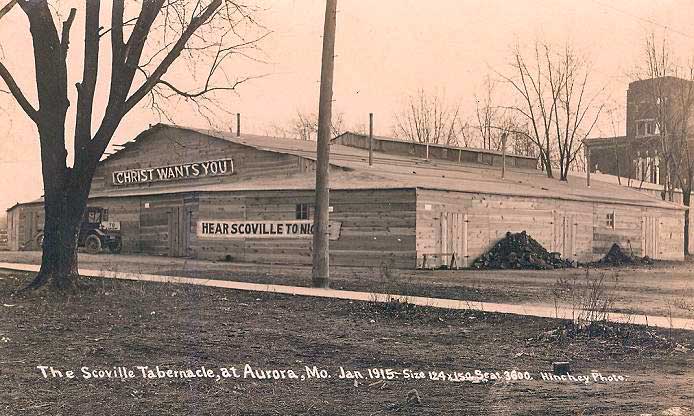
|
1. Notice the building was built around existing trees. At least one tree is inside of the buiding.
2. It appears the tabernacle was built by closing West Pleasant Street, in front of the Disciples of Christ building at South Washington Avenue and W. Pleasant. The tree inside of the building was actually one of the trees at the north edge of West Pleasant.
3. The building was heated by coal seen stacked in the foreground along with the coal shovel.
4. There was probably a balcony inside because of the raised and windowed portion of the roof.
5. The tabernacle seated 3,600 people. The population of Aurora in 1920 was 3,576. Is that optimism?
6. While this tabernacle was being used, the one pictured below was being constructed in Akron, Ohio for a meeting that began February 7th. It appears to be larger than this one in Aurora.
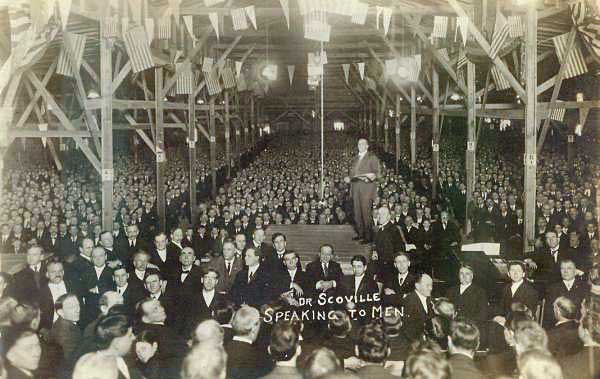
Following the Aurora Campaign, Dr. Scoville began
the Akron meeting where 5,124 were immersed.Scoville Reached Males
Charles Reign Scoville baptized a high percentage of men. He appealed to men. Notice the men in the photo above. In the large staff photo, five of the seven were men. His training teams went ahead of his meetings and trained the men's class in the churches on how to present the gospel to their friends. He emphasized male leadership in the home and in the church. Men brought men to the evangelistic campaigns and men became Christians.
Another taste of the era comes from this Witchita, Kansas photo. The elephants were on parade that day and down front in the center is a Scoville banner.
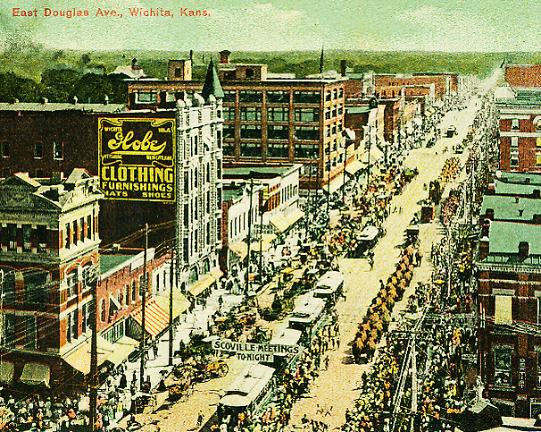
See banner at the bottom in the center.
To help researchers, we have included a list of known meetings, both union and otherwise. Most were taken from Scoville's stationery, advertising and book of sermons. Baptism are recorded in blue. Other decisions were not logged.
Adelaide (1912), Akron (1915 - 5,124), Anderson (1,269), Aurora MO (1915), Beatrice, Bethany MO, Beaumont, Billings (1911), Bloomington IN, Butler IN, Chicago, Cleveland, Columbus, Dallas, Decatur IL (1922 - 254), Des Moines (1901 - 573), (1909) - 1,112) , Emporia KS (4,117), Evansville IN, Gainesville TX (located 2 months in 1901), Fresno, Hutchinson, Houston, Indianapolis, Jacksonville FL (1913), Jefferson City MO (4,150) , Johnstown, Kankakee IL (1926) , Kansas City, Keokuk IA (Feb.-Mar. 1913 3,640), Lawrenceville, IL (1924), Lincoln, Neb. (1907 - 1,500) , (1913), Little Rock, Logansport, Long Beach (1935), Louisville, Melbourne (1912), Minneapolis, New York, Nevada MO, Noblesville IN, Oklahoma City (1,512), Ottumwa IA, (1916), Pamona CA (1931), Pasadena CA, Perth (1912), Pittsburgh PA, Portland OR, Pueblo CO (4,175), Sacramento CA, Scottsdale PA (1927), Shelbyville TN (1937) Shreveport LA, Sidney (1912), Spokane (1910), Springfield, Tacoma WA (1909), Topeka, Wichita, Wichita Falls TX (1914 and 1916 -- 1300+) , Winston Salem, Yakima (1909 - 600) and Youngstown OH.
After trying the union meeting approach for a while, Scoville dropped the concept and returned to holding mass meetings for the Christian Churches and Churches of Christ in a city or county.
At the time of his death, he had just finished a gospel meeting for a single congregation and was headed for Garden City, Kansas to hold a meeting for another congregation.
Australia and Chicago
H. R. Taylor writing in The History of Churches of Christ in South Australia wrote:For a long time reports had been received of the phenomenal success of Charles Reign Scoville, of the United States, in highly organised campaigns in his own land. Plans were made for him to come to Australia with his team in 1912 to conduct missions in some of the capital cities.While in Australia, Mr. Scoville also held campaigns in Sydney, Melbourne and Perth.
Charles Reign Scoville
at about 54 yearsOn August 4 he opened a united mission in the Exhibition Building, Adelaide. All the forces of the churches were harnessed in the huge task of organisation. A complete census was taken of the church affiliations of all the people in the city and suburbs. Prayerful interest resulted from a week's preliminary services in the local congregations.
Literature was distributed freely house to house in successive waves. No participant in the campaign will forget the novel advertisement of a packet of "Everlasting Seeds", a replica of the seedsman's containing passages of Scripture relating to eternal things, and an announcement of the mission, which, while many people may have been momentarily deceived, had great publicity value.
A huge choir was trained by A. J. Gard in readiness for Charles Marty, the evangelistic team's song leader. Night after night crowds flocked to the Exhibition Building. The audiences were thrilled by the singing and held by the magnetic personality of the missioner and his message. During the extended invitation hymns at the close of the address, personal workers, trained by H. F. Phillipi, moved quietly among the audience, encouraging men and women to make their decision.
A canvas baptistry was used each night, and whilst in the opinion of many the dignity and solemnity of the sacred ordinance inevitably suffered, this demonstration of the mode of baptism enjoined by the Lord, accompanied by quotations of Scripture, left a permanent effect on people who had not considered the New Testament teaching on the subject.
The evangelistic team consisted of Mr. and Mrs. C. R. Scoville, C. R. L. Vawter (supporting evangelist), H. F. Phillipi, and Charles Marty. As a result 957 persons confessed their faith in Christ, and 526 united with the churches.
Metropolitan Church of
Christ in Chicago.After returning from a trip abroad, Mr. Scoville became the minister of the Metropolitan Church of Christ at South Levitt and West Van Buren Streets in Chicago. This is just a few steps north of I-290. He preached there about five years and remained a member there for life.
R. A. Long - Backer?
Some sense of Dr. Scoville's effectiveness is seen in a letter that he wrote from Nevada, Missouri to millionaire lumberman Robert Alexander (R. A.) Long of Kansas City, Missouri. Mr. Long was a generous member of the Independence Boulevard Christian Church. Scoville wrote: :
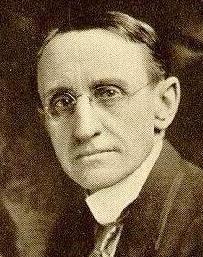
R. A. Long You will be glad to know we have had over 2,000 "line up" here in the opening weeks of this campaign; had 3,500 at Keokuk, Iowa; 4,117 at Emporia, Kansas; 4,150 at Jefferson City. Proportionately speaking, we are reaching a far larger per cent of the inhabitants of the town in which our meetings are held than (Billy) Sunday is reaching in the larger cities.The tone of the letter makes it sound like a report. R. A. Long may have been a financial backer of Mr. Scoville's high-profile, large staff evangelistic meetings.
W. T. Moore, writing a survey of Mr. Scoville in 1918 said:
Mr. Scoville organized and carried with him the largest evangelistic company every carried by an evangelist of the Christian church and he has had the largest ingathering that any evangelist has ever had in the Churches of Christ in America.Mr. Scoville's analysis of his campaign in Spokane, Washington is presented under that heading in our pages. There were "only" 732 responses in this campaign.In the 1930 census, the Scovilles were living near Chicago. Their home was two blocks from Lake Michigan at 219 Golf Terrace in Wilmette Village. Their 15-year-old adopted daughter Ruth was living at home. The census also shows a 41-year-old unmarried lady named Irene Scoville (not related) living at the residence and her occupation is listed as stenographer. The industry that she worked in is listed as EVANGELIST. She told her friend Sophia Myers Rosol of her wonderful memories of working with the Scoville team. Irene later married widower William Nice, minister of a Christian Church in DeKalb County, Indiana.
Inspiration Point
In 1932 the Scovilles moved to the Ozarks. They purchased a Barvarian-like castle on Rock Candy Mountain and had the two-story house completed. It is located six miles west of Eureka Springs, Arkansas at 16311 Highway 62 West. They renamed the location Inspiration Point.
A Newspaper Photo of Mr. Scoville's library is on this link.
A Photo of Mr. Scoville's study is on this link.The 474 acres also included an auditorium with perfect acoustics. It was built to seat 1,000. Some believe that it was modeled after the Mormon Tabernacle in Salt Lake City.
A Newspaper Photo of Mr. Scoville's auditorium is on this link.Inspiration Point was opened for Bible Conferences and general rest and relaxation.
Dodge City, Kansas was Scoville's last evangelistic meeting. In January of 1938 he was to conduct a gospel meeting in Garden City, Kansas when he suffered a heart attack and died. There were two funerals. The service at Garden City was conducted by C. V. Pearce and the Newville, Indiana service was conducted by Dr. Arthur Holmes.
"Christ is King"
Scoville authored such hymns as "Christ is King." His music is still a part of church life where hymns are used. In fact, one of Scoville's advertising slogans was "In Business for the King of Kings."
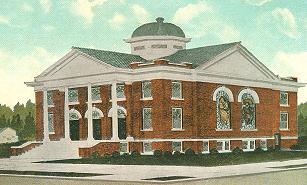
Garden City Christian Church
where C. R. Scoville's funeral was held.The Lincoln Christian College web site states:
Charles Reign Scoville (born in 1869). Entered full-time evangelistic efforts in 1901, married Arlene Dux of Chicago, Illinois, teamed up with DeLoss Smith (his pianist and song leader) for many years, founding with him a joint publishing company for sacred music in 1906 (Scoville-Smith Publishing House in Chicago, Illinois). He wrote many hymns, including "Christ is King (1905)." His publishing ventures sold more than four million hymnals from 1906-1920.It is noteworthy that 1938 was the year of passing for both DeLoss Smith and Charles Reign Scoville.Link to see the words and hear the music of Christ is King.For the printable sheet music, click here.
Marion McKee remembers (in 2003) Arlene Scoville singing for a preaching campaign he was holding in Eureka Springs. He visited the castle during that early part of 1938.
The Scovilles made a record and it was distributed by Standard Publishing. We are looking for a copy to play on this page.
Final Matters
Following Dr. Scoville's death, Arlene gave Inspiration Point to Phillips University and married William F. Rothenberger in 1943. He died in 1959, leaving her a widow a second time. She is buried beside her second husband in the Crown Hill Cemetery in Indianapolis, Indiana.
Mr. Scoville is buried near his birth place in Newville, Indiana.
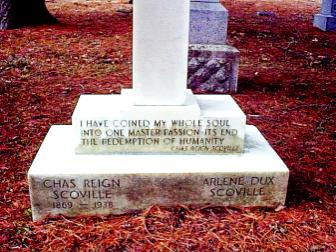
-- photos courtesy of Darrin Langford Main Pioneer Menu | Profiles Index | Search Engine
